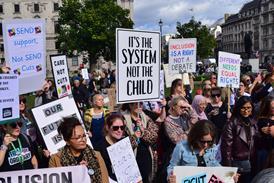Striving to find a common language
As the European court of justice celebrates its 50th anniversary, it is trying to resolve internal differences, says Jeremy Fleming
The European Court of Justice (ECJ) is celebrating its first 50 years.
In fact, the court itself is not 50 years old, but it can trace its ancestor courts that far.
In 1952, a court was established to supervise the power of the so-called high authority established by the European Coal and Steel Treaty of that year, created by France, Germany and Italy after the Second World War as a means of ensuring that the raw building materials of conflict were put under a mutual control structure.
By 1958, the court's jurisdiction expanded as the Treaty of Rome set up the European Economic Community and the European Atomic Community was created.
When it first sat in 1952, the court used the dining room of a private villa on the outskirts of Luxembourg City; now it has its own dedicated building in the 'European quarter'.
There are 15 judges in the court - one appointed for each member state - and nine advocates-general, whose job is to deliver independent opinions on cases before the court.
In addition, there are ten judges at the court of first instance (CFI).
As with the judges, the advocates are all members of the court and are nominated by the individual member states from which they come, although they may only be appointed with the consent of all the other member states.
In the past ten years, the appointment of British judges has changed.
Judge David Edward - a judge of the CFI until 1992, when he became an ECJ judge - was nominated informally by the Foreign Office.
His appointment was then approved by Margaret Thatcher originally (when he arrived at the CFI in 1989), and subsequently by John Major when he became a judge of the main court in 1992.
It is a royal appointment, like those of other judges in the UK, but nowadays it is done by an appointments commission within the Lord Chancellor's Department.
This is how Nicholas Forwood, currently a judge in the CFI, was appointed.
Judge Edward explains that the court's cases have run in rhythms.
'Looking back to the 1960s and 1970s, they mainly concerned agriculture, customs and competition involving the free movement of goods.
In the 1980s, it moved on to sex discrimination, with lots of employment cases brought under TUPE [the Transfer of Undertakings Protection of Employment) Regulations].'
But since he was appointed an ECJ judge in 1992, he says that the shift has been to cases concerned with the freedom of movement of persons, environment and consumer protection, and VAT cases.
Another trend, Judge Forwood says, is that the complexity of the cases appearing before the court is always increasing.
Both men are well-placed to see the likelihood and potential for further legal integration within the European Union (EU).
Judge Edward says: 'The notion of there being a common law/civil law split in Europe is exaggerated.
There are 15 systems of law and it's a juridical zoo.
The potential incompatibilities within the coded systems and the common law ones themselves is enormous.' For this reason, Judge Edward predicts the notion of a single commercial contract code - currently under preliminary consideration by the Council of Ministers - is highly improbable.
'It would just take too long to implement,' he says.
It is not just the differences in the rules that matter, says Judge Edward.
'It's more fundamental than that.
Underlying the rules is a series of assumptions about who takes responsibility for what, how a contract will take place, and the extent to which you are free to contract.
There are substantial differences as to freedom to contract.'
Judge Forwood adds: 'It's not a question so much about the substantial provisions of the law, but the attitude that's taken to the statutes.
Simplistically speaking, under the common law there is an assumption that the parties to the contract have considered everything, whereas continental systems leave it to the law and the parties to deal with the general principles, and leave it to court to find the details from that.'
Harmonisation is best left to a form of organic understanding, according to Judge Edward.
He says that one important factor is that British lawyers are increasingly aware of doing things differently from their continental colleagues.
Textbooks are increasingly explaining how different legal problems - whether contract or tort - are dealt with across European jurisdictions.
'The awareness that grows from these texts will have an osmotic affect of familiarising lawyers more and more with each other's systems,' he says.
Judge Forwood says: 'I have a leaning in favour of natural selection.
There is a positive advantage in having a number of co-existing systems.
The ECJ is permitted to borrow interpretations from national law.
And now we are also seeing a reverse osmosis.
National courts are drawing on community law.'
One problem that the judges find is that they become involved in difficult interpretation resulting from inefficiencies within the EU's executive.
Judge Forwood says: 'Sometimes the Council of Ministers will leave it to their civil servants to hammer out a wording agreement on legislation and find it impossible to agree a form of words.
Instead, they leave a kind of mulch.'
An example can be seen in the company accounts directive, he says, in which two definitions were included: an Anglo-American accounting standard - stipulating that balance sheets should be drawn up on a 'true and fair view' basis - and the European standard, which states that balance sheets should be a 'precise statement of the assets and liabilities of a company'.
The result is confusion over which system companies are obliged to follow.
It does make a difference, as Judge Forwood explains.
'If you have a builder who is calculating potential liability for defective work, is he required to allow a sum for each house for the potential liability (as he ought under the European approach), or should he take a mean figure in respect of liability for all 20 houses, as he might if applying a "true and fair" definition?'
The problem with issues such as this is that they are either identified by the civil servants and deliberately left vague, or are not identified at all, he says.
Within a building where so many nationalities are represented among high-powered judges, it might seem as though the national interests and jealousies are likely to emerge.
But both judges insist that the structure of the court is designed to avoid this.
Firstly, all decisions are made by the court unanimously - there can be no dissenting opinions.
Judge Edward explains: 'I simply cannot predict from one day to the next what attitude my colleagues will have in any given case.
We are emphatically not here to represent our national interests.
There is always the problem though - like the US Supreme Court - that individual judges might become associated with a particular point of view.'
The court has come a long way in the past 50 years, so what of the next half century? As European directives come thicker and faster, and the demand for appeals increases, how will the court that started its life sitting in a dining room of a mansion evolve? Perhaps a network of federal courts within each member state?
Judge Edward muses: 'I suppose it's possible that you'll get a system of federal community courts in 50 years' time, but I'd be surprised.'
He says there are two reasons why it is unlikely.
'First, the system is extremely successful as it stands, and secondly, because of the language problem.'
All the judicial decision-making and conferring is conducted in French, which in general and by tradition is the language of the court.
But the language of proceedings depends upon the case.
Where an applicant applies for an annulment, the language is that of the applicant.
Where the action is one brought against a member state for failure to act, the language is the language of the member state involved; and in preliminary rulings - in which member states request guidance from the court - proceedings are carried out in the language of the state applying for the ruling.
Furthermore, once decisions are made, these must then be disseminated in the 11 official languages of the EU.
Each language has a staff of 30 translators attached to it - a massive expense, as they make up half of the court's total staff.
Despite the army of linguists, the court is run efficiently in comparison to other EU institutions, taking up about 0.01% of the EU's total budget.
Judge Edward says the funding of the court is inadequate given the role it plays in making the terms of trade between member states clearer.
He says: 'In the US, the efficiency of the courts system is a matter of acute public interest, but not so in Europe, where frivolous attitudes can be struck.'
He continues: 'Leaving aside the need that will arise for greater resources with new countries added to the EU, and further integration, the need for additional costs in the ECJ is peanuts compared to the hidden cost of inefficiency in business terms of not funding it properly.'
If federal regional courts were created, devolving this language capability would be difficult, expensive and highly controversial.
'The language of the court is currently French and it would be difficult to imagine that going down well in Wolverhampton,' says Judge Forwood.
Nowhere more than in the ECJ is the insuperable barrier to an integrated Europe - the barrier of language - more visible.
It seems unlikely that more ambitious integration will be achieved without this Tower of Babel being raised and a single language of communication applied.
The problem - and it is such a hot potato that nobody mentions it in Brussels - is: which language?


























No comments yet